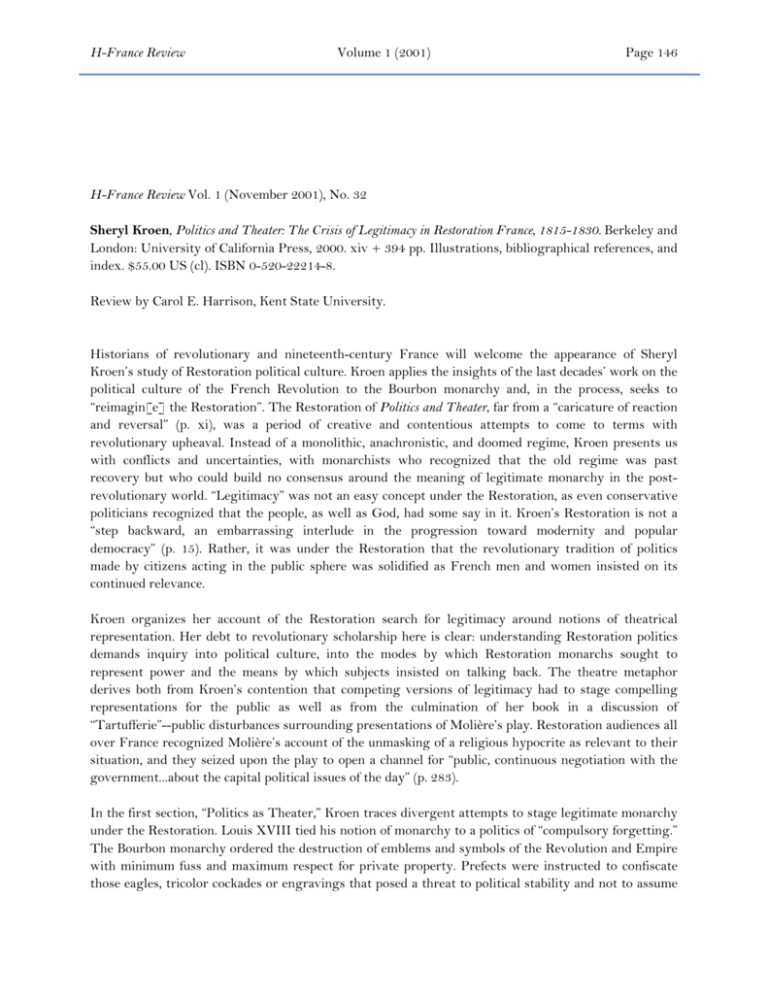
H-France Review
Volume 1 (2001)
Page 146
H-France Review Vol. 1 (November 2001), No. 32
Sheryl Kroen, Politics and Theater: The Crisis of Legitimacy in Restoration France, 1815-1830. Berkeley and
London: University of California Press, 2000. xiv + 394 pp. Illustrations, bibliographical references, and
index. $55.00 US (cl). ISBN 0-520-22214-8.
Review by Carol E. Harrison, Kent State University.
Historians of revolutionary and nineteenth-century France will welcome the appearance of Sheryl
Kroen’s study of Restoration political culture. Kroen applies the insights of the last decades’ work on the
political culture of the French Revolution to the Bourbon monarchy and, in the process, seeks to
“reimagin[e] the Restoration”. The Restoration of Politics and Theater, far from a “caricature of reaction
and reversal” (p. xi), was a period of creative and contentious attempts to come to terms with
revolutionary upheaval. Instead of a monolithic, anachronistic, and doomed regime, Kroen presents us
with conflicts and uncertainties, with monarchists who recognized that the old regime was past
recovery but who could build no consensus around the meaning of legitimate monarchy in the postrevolutionary world. “Legitimacy” was not an easy concept under the Restoration, as even conservative
politicians recognized that the people, as well as God, had some say in it. Kroen’s Restoration is not a
“step backward, an embarrassing interlude in the progression toward modernity and popular
democracy” (p. 15). Rather, it was under the Restoration that the revolutionary tradition of politics
made by citizens acting in the public sphere was solidified as French men and women insisted on its
continued relevance.
Kroen organizes her account of the Restoration search for legitimacy around notions of theatrical
representation. Her debt to revolutionary scholarship here is clear: understanding Restoration politics
demands inquiry into political culture, into the modes by which Restoration monarchs sought to
represent power and the means by which subjects insisted on talking back. The theatre metaphor
derives both from Kroen’s contention that competing versions of legitimacy had to stage compelling
representations for the public as well as from the culmination of her book in a discussion of
“Tartufferie”--public disturbances surrounding presentations of Molière’s play. Restoration audiences all
over France recognized Molière’s account of the unmasking of a religious hypocrite as relevant to their
situation, and they seized upon the play to open a channel for “public, continuous negotiation with the
government...about the capital political issues of the day” (p. 283).
In the first section, “Politics as Theater,” Kroen traces divergent attempts to stage legitimate monarchy
under the Restoration. Louis XVIII tied his notion of monarchy to a politics of “compulsory forgetting.”
The Bourbon monarchy ordered the destruction of emblems and symbols of the Revolution and Empire
with minimum fuss and maximum respect for private property. Prefects were instructed to confiscate
those eagles, tricolor cockades or engravings that posed a threat to political stability and not to assume
H-France Review
Volume 1 (2001)
Page 147
that all possessors of such memorabilia were dangerous revolutionaries. Bourbon discussions of the
Revolution prudently neglected to name the guilty: even the (carefully underplayed) official
commemorations of the executions of Louis XVI and Marie Antoinette cast the French people as
suffering mourners, not as regicides. In the words of a proposal from the Chamber of Deputies, such a
ceremony would “free the French from a crime of which they were never guilty” (p. 63). In the Bourbon
staging of monarchy, settling the accounts for revolutionary crimes mattered less than celebrating “the
peaceful, happy alternative which monarchy offered to the reign of disorder and anarchy” (p. 56).
The Bourbon monarchs’ version of the revolutionary interregnum and of their own authority faced
challenge even from their friends, however. Conservative Catholics proposed a dramatically different
reading of France’s recent history, one that found culpability everywhere. The Revolution demonstrated
that France had become a “spiritual desert” (p. 83) in need of reconversion, and the Church obliged with
a series of missions that emphasized widespread complicity in revolutionary sins. Missionaries did not
shrink before the task of identifying--and naming--the guilty: revolutionary collaborators, purchasers of
biens nationaux, constitutional priests, and revolutionary soldiers. They asked ordinary French people to
examine their souls carefully, to consider their part in the national expiation, and to contemplate closely
the hellfire that awaited them. Ultimately, it was the Church, not the monarchy, that most thoroughly
attempted to “resacralize the public sphere in the name of Christ and their king” (p. 101).
These competing versions of what legitimate monarchy might mean in the nineteenth century
destabilized the Restoration and opened up a space for popular politics. In general, the Bourbon
monarchy and its civil servants attempted to curb the activities of the missionaries by supervising
sermons, scheduling revivals to avoid carnival season, banning nighttime preaching, and regulating the
erection of crosses. Prefects and mayors regularly refused to attend missionary ceremonies. No
Bourbon, however, could imagine a purely secular monarchy, so there were very real limits on the
state’s ability to distance itself from the Church. In Kroen’s account of Church-state relations under the
Restoration, the Sacrilege Law and the other clerical policies of 1825-1826 were an aberration--albeit a
significant one--in Bourbon attempts to give monarchy a civil, as well as a sacred, foundation. Bourbon
officials recognized, and even shared, popular distaste for the expiatory spectacles of the Church, but the
regime could only curtail the missionaries’ excesses; it could not fundamentally challenge their
representation of a divinely ordained political order.
Crucial to Kroen’s contention that monarchy was intrinsically theatrical is her insistence that its
audience mattered. Part two, “Theater as Politics” turns to the spectators of monarchy, in particular to
the popular opponents of the Bourbon settlement. In general, the audience objected far more
strenuously to the missionaries’ version of a resacralized monarchy than to monarchy per se. Kroen’s
careful documentation of the popular politics of the Restoration--seditious cries, pamphlet literature,
coins defaced to give Charles X the appearance of a Jesuit, tricolors that appeared on all manner of
consumer goods, parodies of sacraments--brings many of the insights of revolutionary scholarship to the
political culture of the post-revolutionary decades. The Revolution had unleashed a repertoire of
symbols and practices that made nonsense of the Bourbon policy of forgetting. Kroen’s work here fits
nicely with explorations of popular political idioms and the politicization of folkloric practices that have
characterized research on the revolutions of 1789 and 1848.
H-France Review
Volume 1 (2001)
Page 148
Tartuffe and its effect on Restoration audiences capture the ambiguities of the period’s anticlerical and
antimonarchical politics. Theatregoers demanded Tartuffe, read Tartuffe from the seats over
performances of other plays, circulated engraved illustrations of scenes from the play, and generally
cheered Molière’s unmasking of the officious hypocrite. The most anticipated line of the play was the
announcement of the deus ex machina ending in which the king’s bailiff arrives to save the family from
Tartuffe’s hypocrisy: “Rest easy, and be grateful/ We serve a Prince to whom all fraud is hateful/ A
Prince who sees into our inmost hearts,/ And can’t be fooled by any trickster’s arts.” The hoots and
cheers that accompanied these verses clearly announced the audience’s expectation that their king, too,
would be immune to the hypocrisy of the missionaries. They also, however, raised the possibility that he
might be falling victim to the machinations of a new Tartuffe, or, even worse, that the king was
becoming Tartuffe--that Charles X was, as rumor held, a Jesuit.
Not surprisingly in a book that opens up so much new terrain, Theater and Politics hints at some
interesting questions that it doesn’t actually address. Although Kroen’s Bourbon regime is a complex
affair, characterized by its contradictions, her Catholic Church remains a monolithic institution. Kroen
contrasts a “new Catholicism,” dedicated to restoring the sacred basis of the French state and to putting
the fear of God into as many actual or potential revolutionaries as possible, with a nostalgic “old
Catholicism,” a pre-revolutionary faith which allegedly existed in harmony with local customs (p. 94).
Debates within the Church, particularly concerning its proper relationship to the state, do not register
in this account. Those clerical voices calling for an ultramontane Catholicism with closer ties to Rome
than to Paris and warning of the dangers of dependence on the obviously fallible French state make no
appearance on Kroen’s stage. Nonetheless, such views did exist within French Catholicism, and their
position in a more complex and multifaceted Restoration deserves attention. It seems likely, for
instance, that some of the missionaries’ expiatory zeal was aimed at Catholic dissent. Depicting the
missionaries as representatives of an undifferentiated Catholic counter-revolutionary rage would thus be
too simple.
Similarly, Kroen’s research suggests interesting avenues in the study of gender and political culture.
Women were prominent in the missionaries’ congregations, sometimes overwhelmingly so, as in the
revival that attracted, according to the prefect’s report, over “1500 women and 25 men in attendance
with their candles.” (p. 105). Often the authorities sympathized with anticlericals’ view that women were
the missionaries’ pawns: vulnerable women seduced by missionaries invited priests into their marriages
and threatened family stability. It would be interesting to know what the missionaries made of their
predominantly female congregations. Lest we assume that Kroen is simply documenting another facet of
a “catholicisme au féminin,” we should note that women also appeared among Tartuffe audiences. In the
case of Tartuffe performances in Brest, for instance, the spectators were “principally the women of the
town” (p. 138). Certainly the argument about the place of the Church in the modern French state was
often cast as a debate about the place of the Church in the lives of French women. In Theater and Politics,
however, we see repeated vignettes of women in the public sphere actively engaging in these debates,
both cheering Tartuffe’s fall and confessing their sins against Church and king. Kroen gives us a good
deal of material with which to rethink the assumption that the practice of politics in the postrevolutionary period was gendered male.
France’s early nineteenth-century monarchies have not been hotbeds of scholarly inquiry in the past
decades; the revisionist Revolution has absorbed researchers’ attention. Kroen convincingly argues,
H-France Review
Volume 1 (2001)
Page 149
however, that we cannot claim the French Revolution as the “birth of modern political culture” without
examining the itinerary of democratic politics across the nineteenth century, including its less
democratic regimes. Sheryl Kroen has suggested multiple avenues for that inquiry. Politics and Theater
demonstrates that democratic political culture did not simply survive a stultifying and repressive
Restoration. On the contrary, the politics of popular participation remained important both to the
monarchists and Catholics who sought to define legitimacy as well as to those French men and women
who objected to the definitions they proposed.
Carol E. Harrison
Kent State University
charris1@kent.edu
Copyright © 2001 by the Society for French Historical Studies, all rights reserved. The Society for
French Historical Studies permits the electronic distribution of individual reviews for nonprofit
educational purposes, provided that full and accurate credit is given to the author, the date of
publication, and the location of the review on the H-France website. The Society for French Historical
Studies reserves the right to withdraw the license for redistribution/republication of individual reviews
at any time and for any specific case. Neither bulk redistribution/republication in electronic form of
more than five percent of the contents of H-France Review nor re-publication of any amount in print
form will be permitted without permission. For any other proposed uses, contact the Editor-in-Chief of
H-France. The views posted on H-France Review are not necessarily the views of the Society for
French Historical Studies.
ISSN 1553-9172









